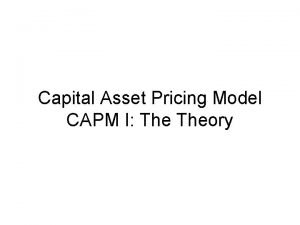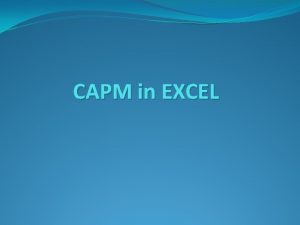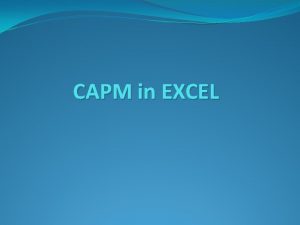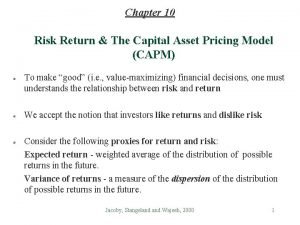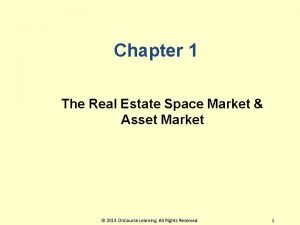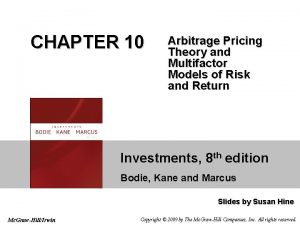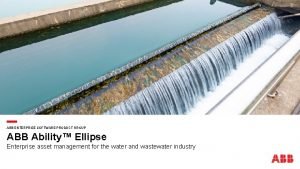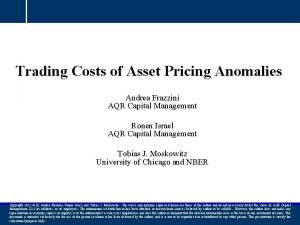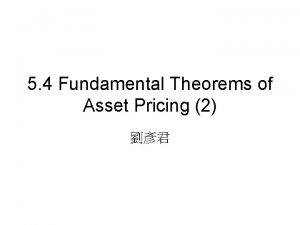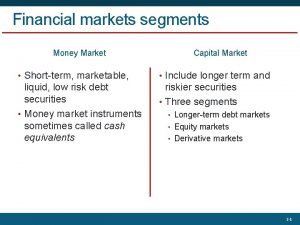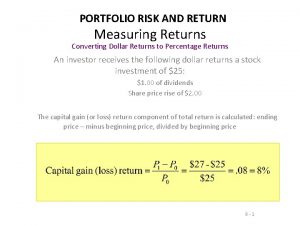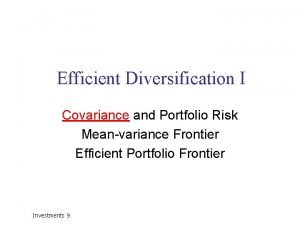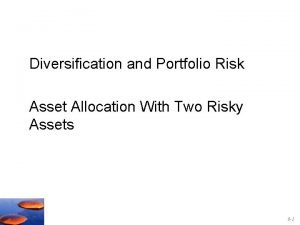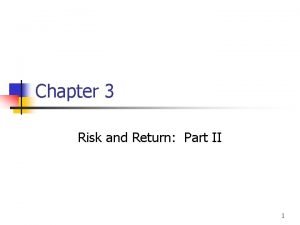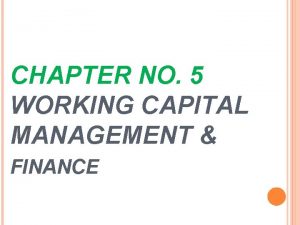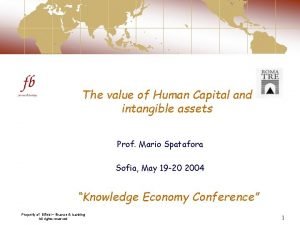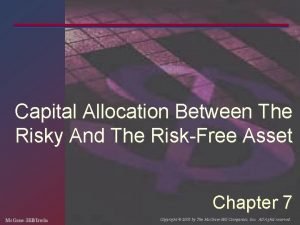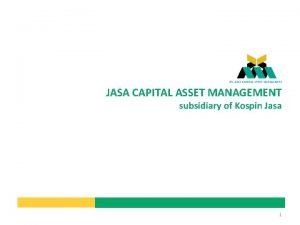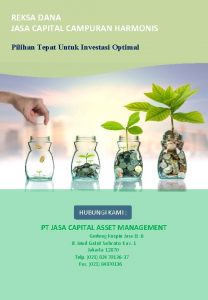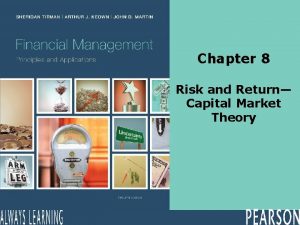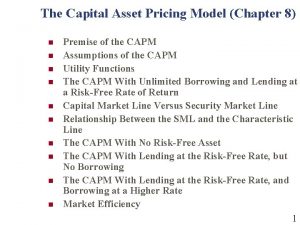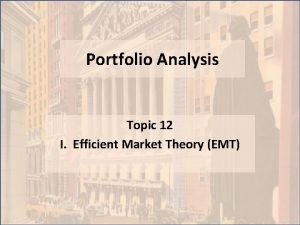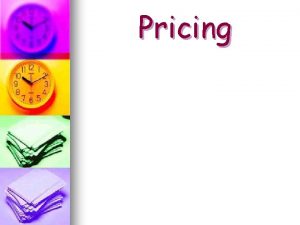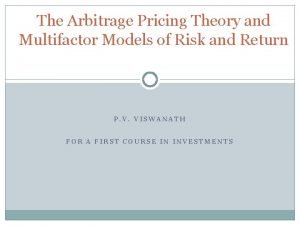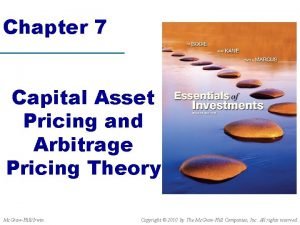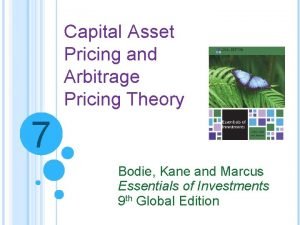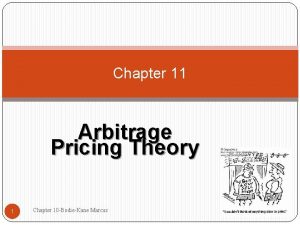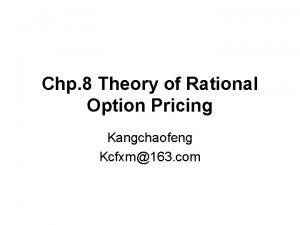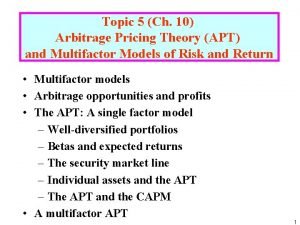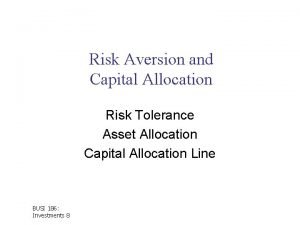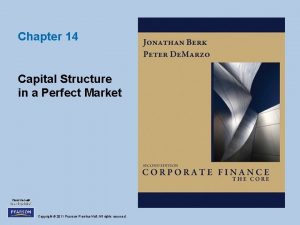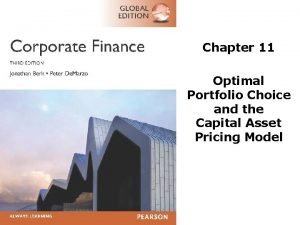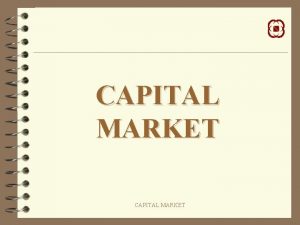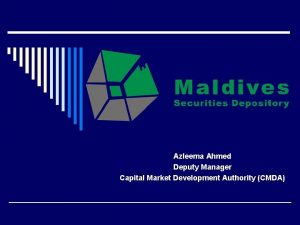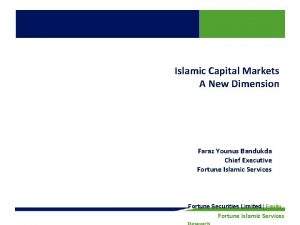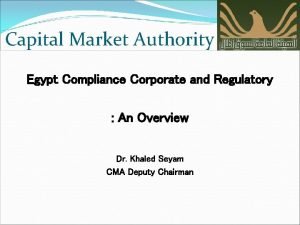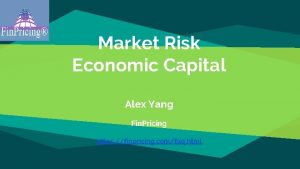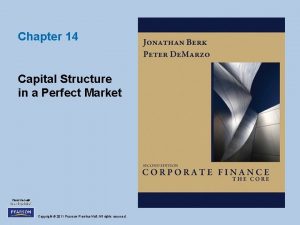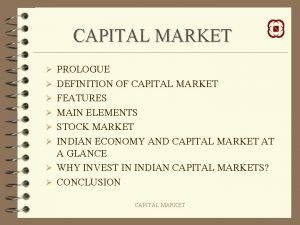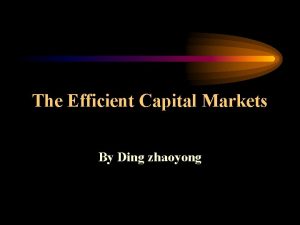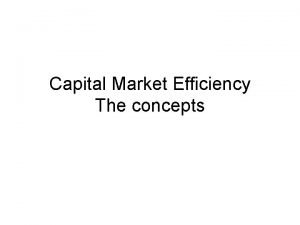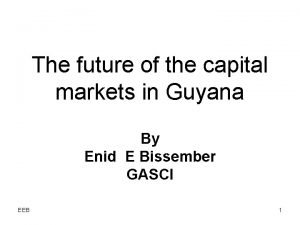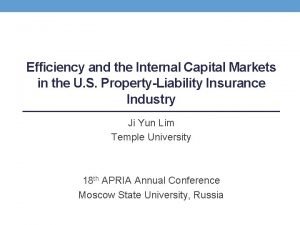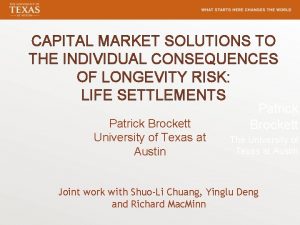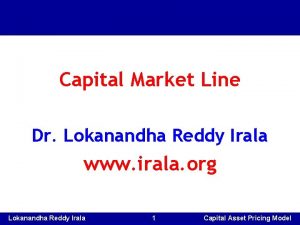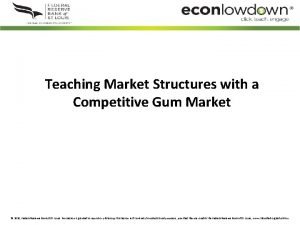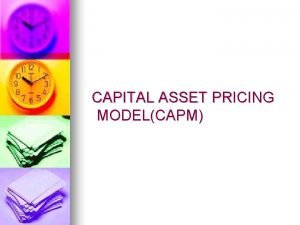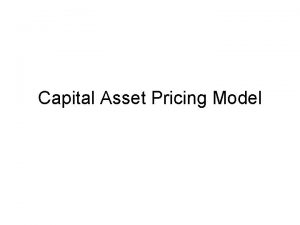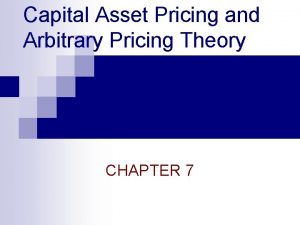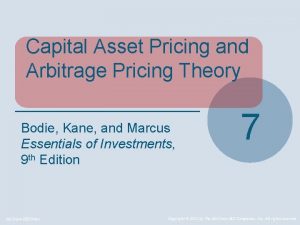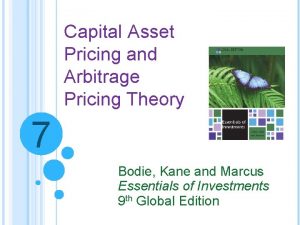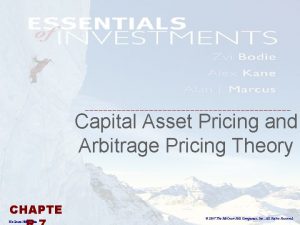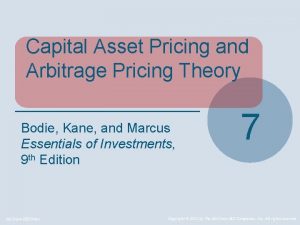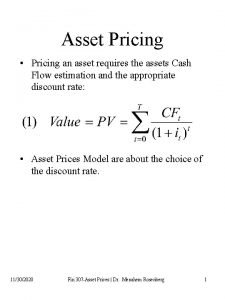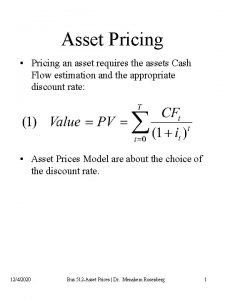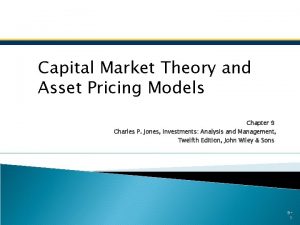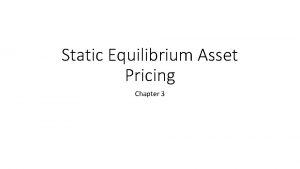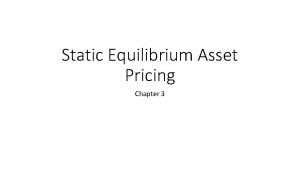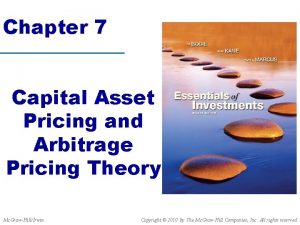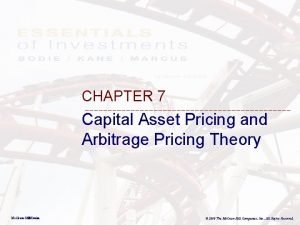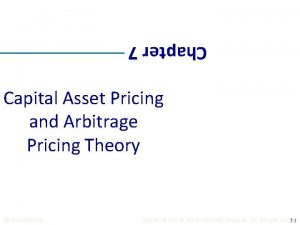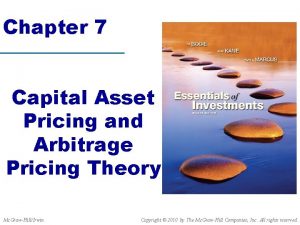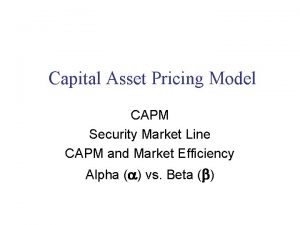Portfolio Theory Capital Market Theory Capital Asset Pricing












































![SML : Security Market Line E(Ri) = Rf + [(E(Rm) - Rf )/ SD(Rm)] SML : Security Market Line E(Ri) = Rf + [(E(Rm) - Rf )/ SD(Rm)]](https://slidetodoc.com/presentation_image_h2/90be5bbbc0bfcc3d9e9432f12b333fde/image-45.jpg)




![SML : Security Market Line Asset Expected Return [E(Rj)] Slope of SML = [E(Rj) SML : Security Market Line Asset Expected Return [E(Rj)] Slope of SML = [E(Rj)](https://slidetodoc.com/presentation_image_h2/90be5bbbc0bfcc3d9e9432f12b333fde/image-50.jpg)











- Slides: 61

Portfolio Theory Capital Market Theory Capital Asset Pricing Model “Do not put all your eggs in one basket 1

Expected Returns Expected return: average return on a risky asset expected in the future. where: Pi = probability of each state of the economy Ri = expected return under each state and Risk premium = E ( R ) - Rf = Expected return – Risk free rate 2

Standard Deviation Standard deviation is calculated as: where: Pi = probability of each state of the economy Ri = expected return under each state E(R) = expected return for the security 3

Example; Stock A gives average return 4% on the normal situation. During the crisis, Stock A plumped and generated negative return -2%. However, Stock A expected to generate return 10% on bullish economy. Given the possibility of crisis, normal, and bullish to be 30%, 50%, and 20% respectively. What is the expected return and standard deviation (total risk) of stock A? E (R) = 0. 30 x ( -2%) + 0. 50 x (4%) + 0. 20 x (10%) E (R) = 3. 4% SDA = [0. 3 x(-2 - 3. 4)2 + 0. 5 x(4 - 3. 4)2 + 0. 2 x(10 – 3. 4)2 ]0. 5 SDA = 4. 2% 4

Calculation of Expected Return 5

Calculation of Standard Deviation 6

Portfolio n Portfolio: Group of assets such as stocks and bonds held by an investor. n Efficient portfolio : portfolio that maximize the expected return given a level of risk. n Optimal portfolio : the most preferred efficient portfolio that an investor selects. n Risk averse investor : with the same expected return but two different risks, he will prefer the lower risk. 7

Portfolio n Portfolio weights: Percentage of a portfolio's total value invested in a particular asset. n Portfolio expected returns: the weighted average combination of the expected returns of the assets in the portfolio. n Portfolio Variance: it is the combination of the weighted average of the individual security's variance and securities’ covariance factor. 8

Portfolio Expected Returns Two ways to calculate portfolio expected return: Xj = weight of each stock in the portfolio E(Rj) = expected return of each stock in the portfolio n = total number of different stocks in the portfolio E(Rps) = expected return of portfolio under state s Ps = Probability of state s m = total number of all states in the future 9

Portfolio Risk n Portfolio variance: var(Rp) = Wi 2 var(Ri) + Wj 2 var (Rj) + 2 Wi. Wj cov(Ri, Rj) cov (Ri, Rj) = p 1[ri 1 - E(Rj) ][rj 1 – E(Rj)] + p 2[ri 2 - E(Rj) ][rj 2 – E(Rj)] + …. + p. N[ri. N - E(Rj) ][rj. N – E(Rj)] Where ; rin and rjn = the nth possible rate of return for asset i and j respectively pn = the probability of attaining the rate of return n for assets i and j N = the number of possible outcomes for the rate of return 10

Covariance and Correlation n Relationship between covariance and correlation: corr (Ri, Rj) = cov (Ri, Rj) SD(Ri) SD(Rj) Correlation represent only the direction between two assets. It values between -1 to +1 Covariance represent both direction and magnitude between two assets. 11

Covariance and Correlation n Calculating covariance and correlation : cov (Ri, Rj) = 0. 50(15 -11)( 8 - 8) + 0. 30(10 -11)(11 -8) + 0. 13( 5 -11)( 6 - 8) + 0. 05( 0 -11)( 0 - 8) + 0. 02(-5 -11)(-4 - 8) = 8. 90 corr (Ri, Rj) = 8. 9 / [(4. 91)(3. 05)] = 0. 60 12

Example: Portfolio Return and Risk 9. 53 12. 81 3. 58 Diversification! = (0. 502)( 4. 912) + (0. 502)(3. 052) + 2(0. 50)(8. 90) = 0. 50 x 11. 05% + 0. 50 x 8% 13

Feasible and Efficient Portfolios Figure 3. 2 ; Feasible and efficient sets of portfolios for stocks C and D E(Rp) 5 30% 20% 10% 3 2 4 1 10% 20% 30% 40% 50% 60% SD(Rp) 14

Feasible and Efficient Portfolios Figure 3. 2 ; Feasible and efficient sets of portfolios for stocks C and D 1 is not include in Markowitz E(Rp) efficient set Because it was Markowitz dominated by 2, 3, and 4 efficient frontier 5 30% Space on the left side of 2, 3, 4, 4 and 5 are not attainable from 20% 3 combinations of C and D. 6 2 10% Space on the right side of 1 2, 3, 4, and 5 are not include in Markowitz efficient set. i. e. 6 has same return as 2 but 6 10% 20% 30% 40% 50% 60% gives higher risk. In another SD(Rp) word, 6 has same risk as 4 but 15 6 gives lower return

E(r) The minimum-variance frontier of risky assets Efficient frontier Global minimum variance portfolio Individual assets Minimum variance frontier St. Dev. 16

Markowitz Efficient Frontier n Efficient Frontier: Set of portfolios with the maximum return for a given risk level. n Data needed to find Efficient Frontier: – Expected returns on all assets – Standard deviations on all assets – Correlation coefficients between every pair of assets 17

Feasible and Efficient Portfolios U 3 U 2 U 1 Moving from left to right E(Rp) on the frontier, although risk increases, so does the 30% expect return. Which point is the best portfolio to 20% hold? The answer is optimal portfolio depend on the investor’s preference or utility as the trade-off between risk and return. 10% 20% 30% 40% 50% 60% SD(Rp) = Optimal portfolio U 1, U 2, U 3 = Indifference curves with U 1 < U 2 < U 3 18

Correlation Coefficient n n n Correlation: The tendency of the returns on two assets to move together. Corr(RA, RB) or A, B -1. 0 +1. 0 Perfect positive correlation: +1. 0 gives no risk reduction Perfect negative correlation: -1. 0 gives complete risk reduction Correlation coefficient between -1. 0 and +1. 0 gives some, but not all, risk reduction The smaller the correlation, the greater the risk reduction potential 19

Portfolio Diversification: Spreading an investment across a number of assets will eliminate some, but not all, of the risk. 20

Returns Distributions for Two Perfectly Positively Correlated Stocks ( = +1. 0) Stock B Stock A 0 0 Portfolio AB 0 21

Returns Distribution for Two Perfectly Negatively Correlated Stocks ( = -1. 0) Stock A 0 Stock B 0 Portfolio AB 0 22

Risk & Return with 2 Assets E(r) 13% r = -1 r=0 8% r = -1 r =. 3 r=1 12% 20% St. Dev 23

Problem 3 Use the following information to calculate the expected return and standard deviation of a portfolio that is 40% invested in Kuipers and 60% invested in Su. Co. Kuipers Su. Co Expected return, E(R) 30% 28% Standard deviation , . 65. 45 Correlation. 30 E(RP) =. 4 x (. 30) +. 6 x (. 28) = 28. 8% P =. 402 x (. 65)2 +. 602 x (. 45)2 + 2 (0. 4)(0. 65 x. 45 x. 30 = (0. 18262)1/2 = 42. 73% 24

CAPM : Capital Asset Pricing Model n Assumptions ; 1. Two-Parameter Model : Investors rely on E(R) and Risk in making decision 2. Rational and Risk Averse : Investors are rational and risk averse. 3. One-Period Investment Horizon : Investors all invest for the same period of time 4. Homogeneous Expectations : Investors share all expectations about assets 25

CAPM : Capital Asset Pricing Model n Assumptions ; 5. Existence of a risk-free asset and unlimited borrowing and lending at the risk -free rate : Investors can borrow and lend any amount at the risk-free rate. 6. Capital markets are completely competitive and frictionless : The sufficiently large number of buyers&sellers. Also, no transaction costs. 26

CML : Capital Market Line From; Var(Rp) = (WRf)2 Var(Rf) + (Wm)2 Var(Rm) + 2 WRf. Wmcov(Rf, Rm) Since, risk-free asset has no variability, and therefore does not move at all with the return on the market portfolio Var(Rp) = (Wm)2 Var(Rm) Wm = SD(Rp) / SD(Rm) From; E(Rp) = WRf. Rf + Wm E(Rm) ; which WRf + Wm = 1 E(Rp) = (1 -Wm)Rf + Wm E(Rm) E(Rp) = Rf + Wm (E(Rm) - Rf ) Therefore, E(Rp) = Rf + [(E(Rm) - Rf )/ SD(Rm)] SD(Rp) 27

Expected Return CML : Capital Market Line Borrowing Portfolio Capital market line: CML Rp = Rf + [( Rm - Rf )/ SD(Rm)] SD(Rp) Lending Portfolio Efficient Frontier M Market Portfolio Rf Every combination of the risk-free asset and the Markowitz efficient portfolio M is shown on the capital market line (CML) With a risk-free asset available and the Standard Deviation efficient frontier identified, we choose the 28 capital allocation line with the steepest slope

CML : Capital Market Line Because investors have the same optimal risky portfolio given the risk-free rate, all investors have the same CML. What if they have different levels of risk-free rate? return n L 0 CML 1 CM 100% stocks First Optimal Risky Portfolio Second Optimal Risky Portfolio 100% bonds 29

Announcements & News the part of the information that the market uses to form the expectation, E(R). Announcement = expected part + surprise the news that influences the unanticipated return on the stock, U, real news which results in risk. 30

Expected Return or Unexpected Return Total Return = Expected Return + Unexpected Return Total Return - Expected Return = Unexpected Return 31

Risk: Systematic & Unsystematic n Risk: The unanticipated part of the return, the portion resulting from surprises. n Types of risk: – Systematic or “market” Risk that influences a large number of assets. Also called market risk. – Unsystematic or “unique” or “asset-specific” Risk that influences a single company or a small group of companies. Also called unique or assetspecific risk. 32

Components of Risk R - E(R) = Systematic portion + Unsystematic portion R - E(R) = U = m + 33

Portfolio Risk - Std. Dev. Components of Risk Total risk Company-specific risk Diversifiable risk Unsystematic risk Market Risk Non-diversifiable or Systematic risk Number of Stocks in Portfolio 34

Components of Risk n Unsystematic Risk: – “Unsystematic risk is essentially eliminated by diversification, so a portfolio with many assets has almost no unsystematic risk. ” – Diversifiable risk / unique risk / asset-specific risk n Systematic Risk: – Systematic risk affects all assets and can not be diversified away (even in a larger portfolio). – Non diversifiable risk / market risk 35

Systematic Risk (Beta) Systematic risk can not be eliminated by diversification. n Since unsystematic risk can be eliminated at no cost, there is no reward for bearing it. n Systematic Risk Principle: n The reward (expected return) for bearing risk depends only on the systematic risk of an investment. n Measuring Systematic Risk: Beta or Measure of the relative systematic risk of an asset. Assets with betas larger (smaller) than 1 have more (less) systematic risk than market average and will have greater (lower) expected returns. 36

Beta Coefficients Beta Company Coefficient ( i) Exxon 0. 65 AT&T 0. 90 IBM 0. 95 Wal-Mart 1. 10 General Motors 1. 15 Microsoft 1. 30 Harley-Davidson 1. 65 America Online 2. 40 37

Portfolio Beta With a large number of assets in a portfolio, multiply each asset's beta by its portfolio weight, and then sum the results to get the portfolio's beta: 38

Portfolio Beta Amount Invested Portfolio Weights Beta (2) (3) (4) (3) x (4) Haskell Mfg. $ 6, 000 Cleaver, Inc. 4, 000 Rutherford Co. 2, 000 50% 33% 17% 0. 90 1. 10 1. 30 0. 450 0. 367 0. 217 Stock (1) Portfolio $12, 000 100% 1. 034 39

Portfolio Beta n High beta security is more sensitive to market movements n Low beta security is relatively insensitive to market movements. n Sensitivity depends on: – How closely is the security’s return correlated with the market – How volatile the security is relative to the market 40

Portfolio Beta n Beta is computed as: 41

Portfolio Beta is estimated as: Security Returns n ne i L c i t s i r e t c a r a h C Slope = i Return on market % Ri = a i + i Rm + e i 42

Beta & Expected Return of a portfolio with one risky and one risk free asset n If you invest in WA in Asset A and the rest (1 -WA) in Risk-Free Asset (with ß=0), then ßP = WA ßA + (1 - WA) 0 = WA ßA n If you own 40% in A with an expected return of 18%, with the remainder in the Risk-Free Asset with a 8% return. The beta on Asset A is 1. 4. E(RP) = (0. 40) (0. 18) + (1 - 0. 40) (0. 08) = 12% ßP = WA ßA + (1 - WA ) 0 = (0. 40)(1. 4) = 0. 56 43

Why do Betas Differ? n Using daily, weekly, monthly, quarterly, or annual returns. n Estimating betas over short periods (a few weeks) versus long periods (5 -10 years). n Choice of the market index (S&P 500 index versus all risky assets). n Some sources adjust betas for statistical and fundamental reasons (such as Value Line). 44
![SML Security Market Line ERi Rf ERm Rf SDRm SML : Security Market Line E(Ri) = Rf + [(E(Rm) - Rf )/ SD(Rm)]](https://slidetodoc.com/presentation_image_h2/90be5bbbc0bfcc3d9e9432f12b333fde/image-45.jpg)
SML : Security Market Line E(Ri) = Rf + [(E(Rm) - Rf )/ SD(Rm)] SD(Ri) by assuming the unsystematic risk is zero and since, , therefore, E(Ri) = Rf + [cov (Ri, Rm) / var(Rm )] (E(Rm) - Rf ) SML shows that it is not the variance or standard deviation of an asset that affects its return. Actually, Covariance of the asset’s return with the market’s return affects its return. From equation above, positive covariance implies higher expected return than the risk-free asset. However, with positive covariance, it increases the risk of an asset in a portfolio, that’s why investors will buy that asset only if they expect to earn a return higher than the risk-free asset. 45

SML : Security Market Line Assume you wish to hold a portfolio consisting of Asset A and a risk-less asset. Given the following information: Asset A has a beta of 1. 2 and an expected return of 18%. The risk-free rate is 7%. Use Asset A weights of: 0%, 25%, 50%, 75%, and 100%. 46

SML : Security Market Line Proportion Invested in Asset A (%) 0 25 50 75 100 Proportion Invested in Risk-Free Asset (%) Portfolio Expected Return (%) Portfolio Beta 100 75 50 25 0 7. 00 9. 75 12. 50 15. 25 18. 00 0. 30 0. 60 0. 90 1. 20 47

SML : Security Market Line Expected Returns & Betas for Asset A 25 Security market line (SML) 20 15 10 Graphical representation of the linear relationship between systematic risk and expected return in financial markets 5 0 0 0. 2 0. 4 0. 6 0. 8 1 1. 2 1. 4 1. 6 Beta 48

Reward-to-Risk Ratio • Risk premium of X% per unit of systematic risk • Based on CAPM assumptions, the reward-to-risk ratio is the same for all securities. Hence, 49
![SML Security Market Line Asset Expected Return ERj Slope of SML ERj SML : Security Market Line Asset Expected Return [E(Rj)] Slope of SML = [E(Rj)](https://slidetodoc.com/presentation_image_h2/90be5bbbc0bfcc3d9e9432f12b333fde/image-50.jpg)
SML : Security Market Line Asset Expected Return [E(Rj)] Slope of SML = [E(Rj) - Rf] / ßj or = [E(RM) - Rf] SML D E(RA) A E(RM) C Rf ßM= 1. 0 ßA Asset Beta ßj 50

Question; Asset A has an expected return of 12% and a beta of 1. 40. Asset B has an expected return of 8% and a beta of 0. 80. Are these assets valued correctly relative to each other if the risk-free rate is 5%? a. For A: (. 12 -. 05) / 1. 40 = ____ 0. 050 b. For B: (. 08 -. 05) / 0. 80 = ____ 0. 0375 What would the risk-free rate have to be for these assets to be correctly valued? (. 12 - Rf) / 1. 40 = (. 08 - Rf) / 0. 80 Rf = ____ 0. 0267 51

CAPM: Capital Asset Pricing Model n This result gives us the CAPM: The Capital Asset Pricing Model (CAPM) is an equilibrium model of the relationship between risk and return in a competitive capital market. The CAPM shows the expected return for an asset depends on: 1. Pure time value of money: risk-free rate 2. Reward for bearing systematic risk: market risk premium 3. Amount of systematic risk: beta coefficient 52

CAPM: Capital Asset Pricing Model Expected return on a security Risk-free Beta of the = + × rate security Market risk premium • Assume j = 0, then the expected return is RF. • Assume j = 1, then 53

Risk & Return Summary n Total risk: variance (standard deviation) of an asset’s return n Total return: expected return + unexpected return n Total unexpected return= Systematic risk: + Unsystematic risk n Systematic risk: unanticipated events that affect almost all assets to some degree n Unsystematic risk: unanticipated events that affect single assets or small groups of assets 54

Risk & Return Summary n Effect of diversification: elimination of unsystematic risk via the combination of assets into a portfolio n Systematic risk principle & beta: reward for bearing risk depends only on it’s level of systematic risk n Reward-to-risk ratio: ratio of an asset’s risk premium to it’s beta n Capital asset pricing model: expected return on an asset can be written as: E(Rj) = Rf + [E(RM) - Rf] x ßj 55

Arbitrage Pricing Theory n Arbitrage - arises if an investor can construct a zero investment portfolio with a sure profit. n Since no investment is required, an investor can create large positions to secure large levels of profit. n In efficient markets, profitable arbitrage opportunities will quickly disappear. 56

APT: Arbitrage Pricing Theory Model Concept : The return on a security is linearly related to H “factors”. The APT does not specify what these factors are, but it is assumed that the relationship between security returns and the factors is linear. E(Ri) = Rf + bi, f 1[E(Rf 1) – Rf] + bi, f 2[E(Rf 2) – Rf] + …. + bi, fn[E(Rfn) – Rf] 57

Question; You own a stock portfolio invested 30% in Stock Q, 20% in Stock R, 10% in Stock S, and 40% in Stock T. The betas for these for stocks are 1. 2, 0. 6, 1. 5, and 0. 8, respectively. What is the portfolio beta? Solution: ßP =. 3(1. 2) +. 2(. 6) +. 1(1. 5) +. 4(. 8) =. 95 Question; A stock has a beta of 1. 2, the expected return on the market is 17%, and the risk-free rate is 8%. What must the expected return on this stock be? Solution: E[Rj] =. 08 + (. 17 -. 08)(1. 2) =. 188 = 18. 8% 58

Question; Stock Y has a beta of 1. 59 and an expected return of 25%. Stock Z has a beta of. 44 and an expected return of 12%. If the risk-free rate is 6% and the market risk premium is 11. 3%, are these stocks correctly priced? Solution: E[rj] =. 06 +. 113ßj E[r. Y] =. 06 +. 113(1. 59) =. 2397 <. 25 so Y plots above the SML and is undervalued E[r. Z] =. 06 +. 113(. 44) =. 1097 <. 12 so Z plots above the SML and is undervalued Question; what would the risk-fee rate have to be for the two stocks to be correctly priced? Solution: [. 25 - Rf] / 1. 59 = [. 12 - Rf] / 0. 44 , therefore, Rf =. 0703 59

Risks associated with investing in Financial Assets Price risk An asset’s value drops. Default risk The issuer of an asset cannot meet its obligations. Inflation risk The rate of inflation erodes the value of an asset. Currency risk The rate of exchange erodes the value of a foreigndenominated asset. 60

Risks associated with investing in Financial Assets Reinvestment risk The cash flow received must be reinvested in a similar vehicle that offers a lower return. Liquidity risk An asset cannot easily be sold at a fair price. Call risk The issuer of an asset exercises its right to pay off the amount borrowed. 61
 Capm rate of return
Capm rate of return Capital asset pricing model
Capital asset pricing model Capm excel
Capm excel Calculate expected portfolio return
Calculate expected portfolio return Lrmc real estate
Lrmc real estate Multifactor pricing models
Multifactor pricing models Ellipse software training
Ellipse software training Frazzini
Frazzini Fundamental theorem of asset pricing proof
Fundamental theorem of asset pricing proof Capital allocation line vs capital market line
Capital allocation line vs capital market line How to find bond equivalent yield
How to find bond equivalent yield Features of money
Features of money Hypothetical market structure
Hypothetical market structure Steps in market segmentation targeting and positioning
Steps in market segmentation targeting and positioning Variance of 3 asset portfolio formula
Variance of 3 asset portfolio formula Efficient diversification
Efficient diversification Portfolio variance formula
Portfolio variance formula Variance of 3 asset portfolio formula
Variance of 3 asset portfolio formula Mission statement examples for students
Mission statement examples for students Working capital cycle
Working capital cycle Human capital intangible asset
Human capital intangible asset Capital allocation line formula
Capital allocation line formula Jasa capital asset management
Jasa capital asset management Kospin jasa
Kospin jasa Market risk
Market risk Capital market theory
Capital market theory Capital market theory
Capital market theory Penetration pricing adalah
Penetration pricing adalah Arbitrage pricing theory model
Arbitrage pricing theory model Arbitrage pricing theory example
Arbitrage pricing theory example Arbitrary pricing
Arbitrary pricing Arbitrage pricing theory exercises
Arbitrage pricing theory exercises Theory of rational option pricing
Theory of rational option pricing The apt requires a benchmark portfolio
The apt requires a benchmark portfolio Fixed capital and working capital
Fixed capital and working capital Source of capital reserve
Source of capital reserve Multinational cost of capital and capital structure
Multinational cost of capital and capital structure Difference between capital reserve and reserve capital
Difference between capital reserve and reserve capital Regulatory capital vs economic capital
Regulatory capital vs economic capital Regulatory capital vs economic capital
Regulatory capital vs economic capital Variable capital examples
Variable capital examples Multinational cost of capital and capital structure
Multinational cost of capital and capital structure Dominant capital allocation line
Dominant capital allocation line Capital structure in a perfect market
Capital structure in a perfect market Capital market line
Capital market line Structure of indian capital market
Structure of indian capital market Capital market development authority maldives
Capital market development authority maldives Importance of capital market
Importance of capital market The following are advantages of the sml approach
The following are advantages of the sml approach Capital market authority egypt
Capital market authority egypt Yang fin
Yang fin Capital structure in a perfect market
Capital structure in a perfect market Equity capital markets definition
Equity capital markets definition Efficient elements alternative
Efficient elements alternative What is capital market efficiency
What is capital market efficiency Functions of capital market
Functions of capital market Literature review on capital market
Literature review on capital market Capital market solutions definition
Capital market solutions definition Equation of capital market line
Equation of capital market line An efficient capital market is one in which
An efficient capital market is one in which Teaching market structures with a competitive gum market
Teaching market structures with a competitive gum market Market forms of poultry with pictures
Market forms of poultry with pictures
